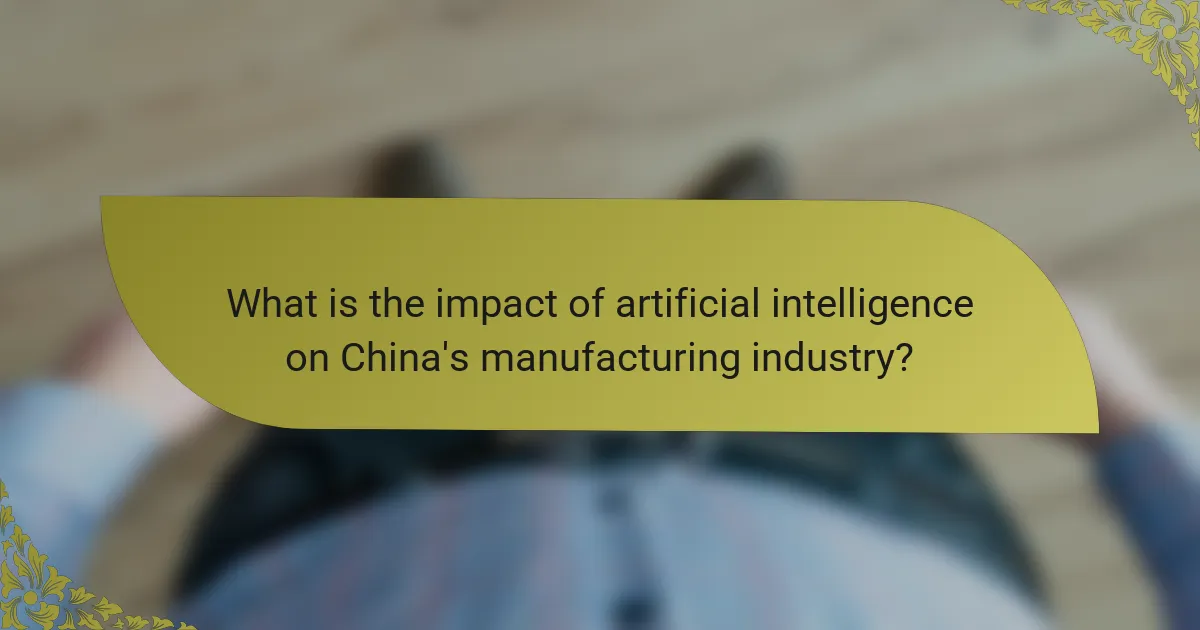Artificial intelligence (AI) is a transformative force in China’s manufacturing industry, enhancing operational efficiency and productivity. By automating repetitive tasks and optimizing production schedules, AI significantly reduces downtime and operational costs. A report by McKinsey highlights that AI could contribute between $1.5 trillion and $2 trillion to this sector by 2030. Furthermore, AI technologies facilitate predictive maintenance, which helps minimize equipment failures and improves resource allocation. Overall, the integration of AI in manufacturing processes fosters innovation and strengthens competitiveness within the industry.

What is the impact of artificial intelligence on China’s manufacturing industry?
Artificial intelligence significantly enhances China’s manufacturing industry. It improves operational efficiency by automating repetitive tasks. AI algorithms optimize production schedules and reduce downtime. This leads to lower operational costs and increased productivity. According to a report by McKinsey, AI could add $1.5 trillion to $2 trillion to China’s manufacturing sector by 2030. Additionally, AI technologies enable predictive maintenance, which minimizes equipment failures. This results in cost savings and better resource allocation. Overall, AI transforms manufacturing processes, driving innovation and competitiveness in the industry.
How is artificial intelligence transforming manufacturing processes in China?
Artificial intelligence is transforming manufacturing processes in China by enhancing efficiency and reducing costs. AI technologies automate tasks, leading to faster production times. Robotics integrated with AI streamline assembly lines. Predictive maintenance powered by AI minimizes equipment downtime. Data analytics improve supply chain management and inventory control. AI-driven quality control systems reduce defects and enhance product quality. According to a report by McKinsey, AI could add $1.2 trillion to China’s manufacturing sector by 2030. These advancements position China as a leader in smart manufacturing.
What specific technologies are driving AI integration in manufacturing?
Machine learning, robotics, and the Internet of Things (IoT) are specific technologies driving AI integration in manufacturing. Machine learning algorithms analyze production data to optimize processes. Robotics automates repetitive tasks, increasing efficiency and precision. IoT devices collect real-time data from manufacturing equipment. This data enhances predictive maintenance and reduces downtime. Additionally, computer vision systems improve quality control by detecting defects. These technologies collectively streamline operations and enhance productivity. For instance, a study by McKinsey found that AI could increase manufacturing productivity by 20 to 30 percent.
How does AI enhance production efficiency in Chinese factories?
AI enhances production efficiency in Chinese factories by optimizing processes and reducing downtime. It achieves this through predictive maintenance, where AI algorithms analyze equipment data to forecast failures. This reduces unexpected breakdowns and minimizes production interruptions. AI also streamlines supply chain management, improving inventory control and demand forecasting. For example, AI systems can analyze market trends to adjust production schedules accordingly. Additionally, automation powered by AI increases the speed and accuracy of manufacturing tasks. According to a report by McKinsey, AI adoption can boost productivity in manufacturing by up to 20%. This demonstrates the significant impact AI has on enhancing efficiency in Chinese factories.
What efficiency gains can be attributed to AI in China’s manufacturing sector?
AI has significantly improved efficiency in China’s manufacturing sector. Automation of production processes has reduced labor costs and increased output. Predictive maintenance powered by AI minimizes equipment downtime. AI-driven data analytics enhances supply chain management and inventory control. Robotics in assembly lines speeds up production rates. Quality control is improved through AI-powered inspections. These advancements lead to higher productivity and lower operational costs. Reports indicate that AI can boost manufacturing efficiency by up to 30%.
How do AI-driven automation systems improve output rates?
AI-driven automation systems improve output rates by streamlining production processes. They enhance efficiency by reducing human error and increasing precision. Automation systems can operate continuously without fatigue, leading to higher throughput. They also optimize resource allocation, ensuring materials and labor are used effectively. Data analytics in AI systems allows for real-time monitoring and adjustments. This responsiveness minimizes downtime and maximizes productivity. Studies show that companies implementing AI automation see output increases of 20% to 30%. This significant improvement is crucial for maintaining competitiveness in manufacturing.
What role does data analytics play in optimizing manufacturing operations?
Data analytics plays a crucial role in optimizing manufacturing operations. It enables manufacturers to analyze vast amounts of data generated during production. This analysis helps identify inefficiencies and areas for improvement. For instance, predictive analytics can forecast equipment failures before they occur. This leads to reduced downtime and maintenance costs. Additionally, data analytics supports better inventory management. It ensures that materials are available when needed, minimizing excess stock. According to a report by McKinsey, companies that leverage data analytics can improve productivity by up to 20%. This demonstrates the significant impact of data-driven decision-making in manufacturing.
What cost reductions are associated with AI implementation in manufacturing?
AI implementation in manufacturing leads to significant cost reductions. These reductions primarily stem from increased operational efficiency. Automation minimizes labor costs by reducing the need for manual intervention. AI-driven predictive maintenance lowers downtime, which can save manufacturers up to 20% in maintenance costs. Enhanced supply chain management through AI optimizes inventory levels, reducing excess stock and associated carrying costs. Additionally, AI can improve quality control, decreasing waste and rework expenses. Overall, these factors contribute to a more streamlined production process, resulting in a substantial decrease in overall operational costs.
How does AI contribute to lowering labor costs in factories?
AI contributes to lowering labor costs in factories by automating repetitive tasks. Automation reduces the need for manual labor. This leads to fewer employees required for production processes. AI systems can operate continuously without breaks. They also increase precision and reduce errors in manufacturing. According to a McKinsey report, automation can reduce labor costs by up to 30%. Additionally, AI-driven predictive maintenance minimizes downtime, further lowering operational costs. Overall, AI enhances efficiency, which directly impacts labor expenditure.
What are the long-term financial benefits of AI investments in manufacturing?
AI investments in manufacturing yield significant long-term financial benefits. These benefits include enhanced operational efficiency and reduced production costs. AI technologies streamline processes, leading to faster production cycles. This efficiency translates into increased output and higher revenue potential.
Moreover, AI reduces labor costs by automating repetitive tasks. According to a McKinsey report, automation can lower labor costs by up to 30% in manufacturing. Additionally, AI systems improve quality control and reduce waste, further cutting costs.
Investing in AI also fosters innovation, enabling manufacturers to develop new products and services. This innovation can lead to capturing new market segments and increased competitive advantage. Overall, the financial benefits of AI investments in manufacturing are substantial, driving growth and profitability over time.
What future prospects does AI hold for China’s manufacturing industry?
AI is expected to significantly enhance China’s manufacturing industry by improving efficiency and reducing costs. Automation powered by AI will streamline production processes. This technology can optimize supply chain management and inventory control. Predictive maintenance using AI will minimize downtime of machinery. Enhanced data analytics will lead to better decision-making. The integration of AI in manufacturing is projected to increase productivity by up to 30% by 2030. According to a report by McKinsey, AI could add $1.5 trillion to China’s manufacturing sector by 2030. These advancements position China to maintain its competitive edge in global manufacturing.
How will advancements in AI technology shape the future of production in China?
Advancements in AI technology will significantly enhance production in China. AI will automate repetitive tasks, increasing efficiency. This automation leads to faster production cycles. AI systems can analyze data in real-time. This capability improves decision-making processes. AI will also enable predictive maintenance of machinery. This reduces downtime and maintenance costs. According to a report by McKinsey, AI could add $1.2 trillion to China’s manufacturing sector by 2030. Furthermore, AI-driven robotics will allow for greater precision in manufacturing. This results in higher quality products and reduced waste. Overall, AI advancements will transform China’s production landscape.
What challenges might the manufacturing sector face in adopting AI technologies?
The manufacturing sector may face several challenges in adopting AI technologies. High initial investment costs can deter companies from implementing AI solutions. Integration with existing systems is often complex and requires significant technical expertise. Workforce resistance to change can slow down the adoption process. Data privacy and security concerns also pose significant risks. Additionally, there may be a shortage of skilled personnel to manage AI technologies effectively. Regulatory compliance can complicate the implementation of AI solutions. Lastly, the rapid pace of technological change can make it difficult for companies to keep up.
How can manufacturers in China effectively integrate AI into their operations?
Manufacturers in China can effectively integrate AI into their operations by adopting advanced technologies and automation. They should start by identifying specific areas where AI can enhance efficiency, such as supply chain management and predictive maintenance. Implementing AI-driven analytics can optimize production processes and reduce downtime. Training employees on AI tools is crucial for successful integration. Collaborating with AI technology providers can facilitate the adoption of tailored solutions. Investing in data infrastructure is necessary to support AI initiatives. Case studies show that companies utilizing AI have reported significant cost reductions and improved productivity. For instance, a report by McKinsey highlights that AI can increase manufacturing productivity by up to 20%.
What best practices should be followed for successful AI implementation?
Successful AI implementation requires clear objectives and alignment with business goals. Organizations should start with a well-defined strategy. This strategy must outline the desired outcomes and metrics for success. Additionally, investing in quality data is crucial. High-quality data drives better AI performance and insights.
Collaboration across departments enhances AI projects. Engaging stakeholders fosters a shared understanding of AI’s role. Regular training and upskilling of employees are essential. This ensures teams can effectively work with AI technologies.
Moreover, iterative development and testing are vital. This approach allows for adjustments based on feedback and performance. Finally, monitoring and evaluating AI systems continuously is necessary. This practice helps in maintaining effectiveness and adapting to changes in the environment.
What common pitfalls should manufacturers avoid when adopting AI solutions?
Manufacturers should avoid several common pitfalls when adopting AI solutions. One major pitfall is insufficient data quality. Poor data can lead to inaccurate AI models and unreliable outputs. Another pitfall is lack of clear objectives. Without defined goals, AI implementations may not deliver expected results. Additionally, manufacturers often underestimate the need for skilled personnel. A lack of expertise can hinder effective AI integration. Resistance to change within the organization is also a significant barrier. Employees may be reluctant to adopt new technologies. Finally, overlooking ongoing maintenance and updates can lead to system obsolescence. Regular updates are crucial for AI systems to remain effective and relevant.
The main entity of this article is artificial intelligence (AI) and its impact on China’s manufacturing industry. The article outlines how AI enhances operational efficiency by automating tasks, optimizing production schedules, and reducing downtime, leading to significant cost reductions and productivity gains. Key technologies driving this transformation include machine learning, robotics, and the Internet of Things (IoT). Additionally, the article discusses the long-term financial benefits of AI investments, future prospects for the industry, and challenges manufacturers may face in adopting these technologies. Overall, AI is positioned as a critical factor in maintaining China’s competitive edge in global manufacturing.



